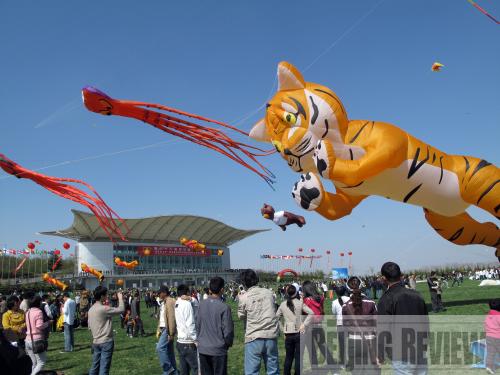 |
|
As part of the 26th Weifang International Kite Festival, a 10,000-person kite-flying performance takes place at Fuyanshan Kite-flying Field on April 21. [Li Xiao] |
Tens of thousands of kite enthusiasts from all over the world gathered under the growing swarm of brightly colored kites. Some of the floating and billowing forms had been fashioned into the shapes of butterflies, tigers and fairytale characters, which danced together in the sky over Weifang City's Fuyanshan Kite-flying Field, Shandong Province, for the annual Weifang International Kite Festival.
Inaugurated in 1984, the Weifang International Kite Festival is an international event starting on April 20 every year. A huge number of kite flyers, collectors and tourists from different countries rush to the event over six days for kite competitions, appreciation and celebration.
This year's festival, celebrating 26 years, included a wide spectrum of activities. There was the fifth World Kite Championship, where kite flyers displayed their unique artistic kites and demonstrated the latest techniques; the 10,000-person kite-flying performance; the kite products fair; the tourism summit of domestic and foreign mayors; and the street parade.
At the fifth World Kite Championship, which was sponsored by the International Kite Federation (IKF), the Chinese Kite Association (CKA) and the Weifang Government, professional flying teams from 23 countries and regions, including the United States, Japan, Germany, Italy and Argentina and some 15 from China, vied for titles in kite fighting and sport kite (compulsory and ballet). Prizes were also up for grabs for those who had the largest and longest kites, the best soft kite, the best performance and the best traditional kite.
Finland's Marten Bondestam was one of the foreign flyers joining the event for the first time.
"I came for friendship, and it is great to be here seeing so many beautiful kites," the 73-year-old said. "I used to be a member of the Finnish League of Sculpture. Of the hundreds of works I made, only three were accepted by the league, and they were all kites. After they were shown to the public was when I started to love kites."
Bondestam brought 40 of his kites to Weifang to compete in the inflatable kite, sport kite ballet and two other categories. Most of his were made of foam plastic instead of cloth and paper. "Because it's cheap," he said.
Weifang is one of China's four major kite-making cities together with Beijing, Tianjin and Nantong of Jiangsu Province. Its kites are famous for their elegant craftsmanship, exquisite design, fine colors, unique shapes and steady gliding. The city's kite-making history spans more than 600 years.
In 1984, the Weifang City Government established the first International Kite Festival with the help of David Checkley, President of the Seattle Kite Association of the United States. It attracted more than 100 participants from 17 kite groups in 11 countries and regions. Enthusiasts came from the United States, Britain, Canada, Australia, New Zealand and Japan. Since then, each April, Weifang hosts a sky full of kites, all finely designed and colorfully decorated.
IKF was established and headquartered in Weifang during the sixth Kite Festival in 1989, and the city was selected the Kite Capital of the World.
The city's intimate relationship with kites stems from China's long history tied to the aerial ornaments.
Sometime in the Spring and Autumn Period (770-476 B.C.), the ancient Chinese were inspired possibly by wind blowing a bamboo hat, tree leaves or a flying bird to create the first kite. Wooden kites and paper kites appeared later. The kite spread to other Southeast Asian countries, Egypt and then to Europe in the 17th century.
It was used for military purposes first, delivering messages and munitions, and then developed functions for observation, scientific experimentation, radio technology and even as light sticks or battery-powered light carriers.
"China has a long tradition of kite flying, but we have been concentrated more on the production methods and craft techniques instead of kite competitiveness like they do in the West," said Su Jie, Acting Secretary General of the CKA.
The Chinese General Administration of Sport introduced revised regulations to catch up with international kite contest standards at the Weifang International Kite Festival. International judges were also invited to participate, Su said.
At the same time, Su stressed, the traditional ways must be maintained as they depict the rich history of Chinese culture.
(Beijing Review, May 4, 2009)